A Study on the Healing Performance of Mortar with Microcapsules Using Silicate-Based Inorganic Materials
Abstract
1. Introduction
2. Materials and Methods
2.1. Microcapsules
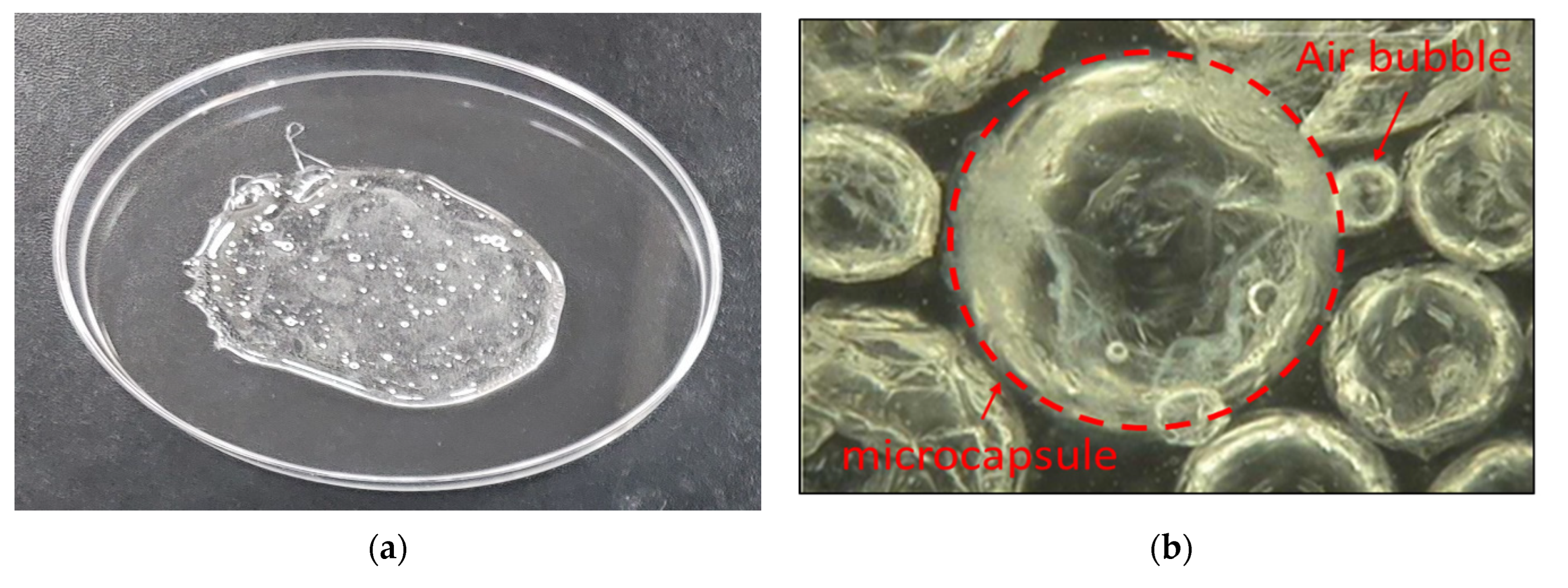

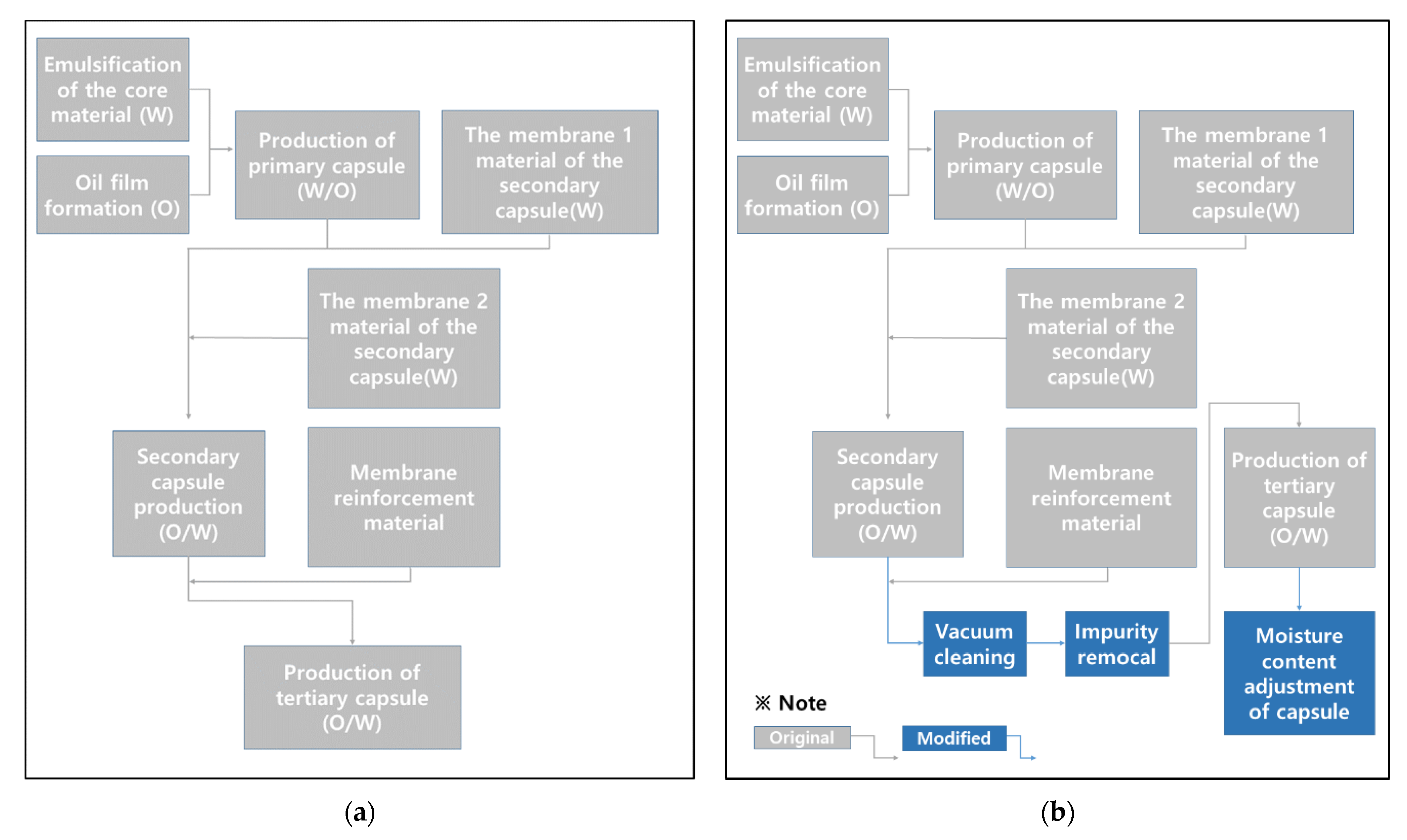

2.2. Mortar
2.3. Quality Properties
2.3.1. Fresh State Test
2.3.2. Hardening State Test
2.4. Self-Healing Properties
2.4.1. Water Flow Test
2.4.2. Crack Closing Test
3. Results and Discussion
3.1. Properties of Fresh Cement Composites
3.1.1. Rheology
3.1.2. Flowability and Air Content
3.2. Mechanical Properties
3.2.1. Compressive Strength
3.2.2. Flexural Strength
3.3. Self-Healing Properties
3.3.1. Water Flow
3.3.2. Crack Closing
4. Conclusions
- According to the results of the analysis on the effects of microcapsules on the rheological properties of mortar, the plastic viscosity, and yield stress were reduced because of the particle properties of the microcapsule. Furthermore, the results showed a decrease in proportion to the microcapsule mixing rate. However, because the core material of the broken microcapsules acted as an alkali activator, the table flow decreased. These results are believed to be more influenced by the loss than by the particle characteristics.
- As a result of evaluating the effect of microcapsules on the mechanical properties of mortar, the strength decreased as the microcapsules were mixed, and the result decreased proportionally as the mixing rate increased. However, the level of reduction is not large, so it is considered that the target performance can be secured.
- As a result of evaluating the effect of microcapsules on the healing properties of mortar, it was confirmed that Plain without microcapsules had natural healing performance, but the healing rate was up to 75.9%, approximately. It is thought that the effect of microcapsules can promote natural healing performance and improve healing rate, and it was found that the healing rate and healing rate accelerated as the mixing rate increased.
Author Contributions
Funding
Institutional Review Board Statement
Informed Consent Statement
Data Availability Statement
Conflicts of Interest
References
- Sangadji, S.; Schlangen, E.; Mimicking, B. Healing process to self repair concrete structure novel approach using porous network concrete. J. Procedia Eng. 2013, 54, 315–326. [Google Scholar] [CrossRef]
- An, E.J.; Shin, M.S. Healing mechanisms and assessment techniques of self-healing concrete. Proc. Korea Concr. Inst. 2014, 26, 477–479. [Google Scholar]
- Alghamri, R.; Al-Tabbaa, A. Self-healing of cracks in mortars using novel PVA-coated pellets of different expansive agents. J. Constr. Build. Mater. 2018, 254, 119254. [Google Scholar] [CrossRef]
- Ahn, T.H.; Kishi, T. Crack self-healing behavior of cementitious composites incorporating various mineral admixtures. J. Adv. Concr. Technol. 2010, 8, 171–186. [Google Scholar] [CrossRef]
- Choi, S.W.; Bae, W.H.; Lee, G.M.; Shin, G.J. Correlation between crack width and water flow of cracked mortar specimens measured by constant water head permeability test. Proceeding Korea Concr. Inst. 2017, 29, 267–273. [Google Scholar] [CrossRef]
- Sharma, N.; Sharma, S.; Sharma, S.K.; Mehta, R. Evaluation of corrosion inhibition and self healing capabilities of nanoclay and tung oil microencapsulated epoxy coatings on rebars in concrete. J. Constr. Build. Mater. 2020, 259, 120278. [Google Scholar] [CrossRef]
- Wan, P.; Liu, Q.; Wu, S.; Zhao, Z.; Chen, S.; Zou, Y.; Rao, W.; Yu, X. A novel microwave induced oil release pattern of calcium alginate nano-Fe3O4 composite capsules for asphalt self-healing. J. Clean. Prod. 2020, 297, 126721. [Google Scholar] [CrossRef]
- Bao, S.; Liu, Q.; Rao, W.; Yu, X.; Zhang, L. Synthesis and characterization of calcium alginate-attapulgite composite capsules for long term asphalt self-healing. J. Constr. Build. Mater. 2020, 265, 120779. [Google Scholar] [CrossRef]
- Nam, E.J. A Study on the Self-Healing Properties of Cement Composites Using Solid Capsules with Crystal Growth Type Inorganic Materials. Master’s Thesis, Semyung University, Jecheon-si, Chungcheongbuk-do, Republic of Korea, 2020. (In Korean). [Google Scholar]
- Choi, Y.W.; Oh, S.R. Technology and practical application of self-healing concrete using capsules. Mag. Korea Concr. Inst. 2020, 32, 21–26. [Google Scholar]
- Nam, E.J.; Oh, S.R.; Kim, C.G.; Choi, Y.W. An experimental study on the self-healing performance of solid capsules according to the composition ratio of crystal growth type inorganic materials. J. Korea Inst. Struct. Maint. Insp. 2021, 25, 16–23. [Google Scholar]
- Choi, Y.W.; Nam, E.J.; Kim, C.G.; Oh, S.R. An experimental study on crack self-healing and mechanical recovery performance of cement composites materials using encapsulated expandable inorganic materials based solid healing materials. J. Korean Recycl. Constr. Resour. Inst. 2022, 10, 92–100. [Google Scholar]
- Park, B.S.; Choi, Y.W.; Park, W.J.; Seo, J.I.; Hong, G.T. The state of the art of self-healing concrete technology. Mag. KSCE 2021, 69, 26–35. [Google Scholar]
- Palin, D.; Wiktor, V.; Jonkers, H.M. Autogenous healing of marine exposed concrete: Characterization and quantification through visual crack closure. J. Cem. Concr. Res. 2015, 73, 17–24. [Google Scholar] [CrossRef]
- Pang, B.; Zhou, Z.; Hou, P.; Du, P.; Zhang, L.; Xu, H. Autogenous and engineered healing mechanisms of carbonated steel slag aggregate in concrete. J. Constr. Build. Mater. 2016, 107, 191–202. [Google Scholar] [CrossRef]
- Huang, H.; Ye, G.; Qian, C.; Schlangen, E. Self-healing in cementitious materials: Materials, methods and service conditions. J. Mater. Des. 2015, 92, 499–511. [Google Scholar] [CrossRef]
- Roig-Flores, M.; Moscato, S.; Serna, P.; Ferrara, L. Self-healing capability of concrete with crystalline admixtures in different environments. J. Constr. Build. Mater. 2015, 86, 1–11. [Google Scholar] [CrossRef]
- Žáková, H.; Pazderka, J.; Reiterman, P. Textile reinforced concrete in combination with improved self-healing ability caused by crystalline admixture. Materials 2020, 13, 5787. [Google Scholar] [CrossRef]
- Sisomphon, K.; Copurogl, O.; Koenders, E.A.B. Self-healing of surface cracks in mortars with expansive additive and crystalline additive. J. Cem. Concr. Compos. 2012, 34, 566–574. [Google Scholar] [CrossRef]
- Jeon, S.; Hossain, M.S.; Han, S.; Choi, P.; Yun, K.-K. Self-healing characteristics of cement concrete containing expansive agent. J. Case Stud. Constr. Mater. 2022, 17, e01609. [Google Scholar] [CrossRef]
- Garces, J.I.T.; Dollente, I.J.; Beltran, A.B.; Tan, R.R.; Promentilla, M.A.B. Life cycle assessment of self-healing geopolymer concrete. J. Clean. Eng. Technol. 2021, 4, 100147. [Google Scholar] [CrossRef]
- Gwon, S.J.; Shin, M.S. Self-healing of modified sulfur composites with calcium sulfoaluminatecement and superabsorbent polymer. J. Compos. Part B 2019, 162, 469–483. [Google Scholar] [CrossRef]
- Abro, F.U.R.; Buller, A.S.; Lee, K.-M.; Jang, S.Y. Using the steady-state chloride migration test to evaluate the self-healing capacity of cracked mortars containing crystalline, expansive, and swelling admixtures. Materials 2019, 12, 1865. [Google Scholar] [CrossRef] [PubMed]
- Choi, Y.C.; Park, B.S. Enhanced autogenous healing of ground granulated blast furnace slag blended cements and mortars. J. Mater. Res. Technol. 2019, 8, 3443–3452. [Google Scholar] [CrossRef]
- Buller, A.S.; Abro, F.U.R.; Lee, K.M.; Jang, S.Y. Mechanical recovery of cracked fiber-reinforced mortar incorporating crystalline admixture, expansive agent, and geomaterial. J. Adv. Mater. Sci. Eng. 2019, 2019, 3420349. [Google Scholar] [CrossRef]
- Park, B.S.; Choi, Y.C. Prediction of self-healing potential of cementitious materials incorporating crystalline admixture by isothermal calorimetry. Int. J. Concr. Struct. Mater. 2019, 13, 36. [Google Scholar] [CrossRef]
- Oh, S.R.; Choi, Y.W.; Kim, Y.J. Effect of cement powder based self-healing solid capsule on the quality of mortar. J. Constr. Build. Mater. 2019, 214, 574–580. [Google Scholar] [CrossRef]
- Milla, J.; Hassan, M.M.; Rupnow, T.; Daly, W.H. Measuring the crack-repair efficiency of steel fiber reinforced concrete beams with microencapsulated calcium nitrate. J. Constr. Build. Mater. 2019, 201, 526–538. [Google Scholar] [CrossRef]
- Al-Tabbaa, A.; Litina, C.; Giannaros, P.; Kanellopoulos, A.; Souza, L. First UK field application and performance of microcapsule-based self-healing concrete. J. Constr. Build. Mater. 2019, 208, 669–685. [Google Scholar] [CrossRef]
- Han, S.; Choi, E.K.; Park, W.; Yi, C.; Chung, N. Effectiveness of expanded clay as a bacteria carrier for self-healing concrete. J. Appl. Biol. Chem. 2019, 62, 19. [Google Scholar] [CrossRef]
- Lee, Y.S.; Park, W.J. Enhanced calcium carbonate-biofilm complex formation by alkali-generating Lysinibacillus boronitolerans YS11 and alkaliphilic Bacillus sp. AK13. J. AMB Express 2019, 9, 1–17. [Google Scholar] [CrossRef]
- Nguyễn, H.H.; Choi, J.-I.; Song, K.-I.; Song, J.-K.; Huh, J.; Lee, B.Y. Self-healing properties of cement-based and alkali-activated slag-based fiber-reinforced composites. J. Constr. Build. Mater. 2018, 165, 801–811. [Google Scholar] [CrossRef]
- Zhang, C.; Guan, X.; Li, J.; Li, Y.; Lu, R. Coupling effect of cementitious capillary crystalline waterproof material and exposure environments on self-healing properties of engineered cementitious composites (ECC). J. Build. Eng. 2023, 63, 105471. [Google Scholar] [CrossRef]
- Blaiszika, B.J.; Sottos, N.R.; White, S.R. Nanocapsules for self-healing materials. J. Compos. Sci. Technol. 2007, 68, 978–986. [Google Scholar] [CrossRef]
- Song, Y.K.; Jo, Y.H.; Lim, Y.J.; Cho, S.Y.; Yu, H.C.; Ryu, B.C.; Lee, S.I.; Chung, C.M. Sunlight-induced Self-healing of a Microcapsule-type protective coating. J. ACS Appl. Mater. Interfaces 2013, 5, 1378–1384. [Google Scholar] [CrossRef]
- Mostavi, E.; Asadi, S.; Hassan, M.M.; Alansari, M. Evaluation of self-healing mechanisms in concrete with double-walled sodium silicate microcapsules. J. Mater. Civ. Eng. 2015, 27, 04015035. [Google Scholar] [CrossRef]
- Kim, C.G. A Study on the Development of Sectional Repair System Utilizing Crack Self-Healing Microcapsules. Ph.D. Thesis, Semyung University, Jecheon-si, Chungcheongbuk-do, Republic of Korea, February 2021. [Google Scholar]
- Choi, Y.W.; Oh, S.R.; Kim, C.G.; Im, H.S. The experimental study on preparation characteristics of self-healing microcapsules for mixing cement composites utilizing liquid inorganic materials. J. Korean Recycl. Constr. Resour. Inst. 2018, 6, 236–243. [Google Scholar]
- Oh, S.R.; Lee, K.M.; Choi, S.; Choi, Y.W. Fundamental Properties and Self-Healing Performance of Repair Mortar with Solid Capsules Made Using Inorganic Reactive Powder. J. Mater. 2022, 15, 1710. [Google Scholar] [CrossRef]
- Kim, C.G. A Study on the Crack Self Healing Properties of Cement Mortar Utilizing Micro Capsules with Liquid-type Inorganic Materials. Master’s Thesis, Semyung University, Jecheon-si, Chungcheongbuk-do, Republic of Korea, February 2018. [Google Scholar]
- Choi, Y.W.; Oh, S.R.; Kim, C.G. A study on crack healing properties of cement composites mixed with self-healing microcapsules. J. Korea Inst. Struct. Maint. Insp. 2019, 23, 113–121. [Google Scholar]
- Oh, S.R. A Study on the Development and Properties of Cementitous Composite Materials Utilizing Capsules for Crack Self-Healing. Ph.D. Thesis, Semyung University, Jecheon-si, Chungcheongbuk-do, Republic of Korea, 2017. (In Korean). [Google Scholar]
- Ikoma, H.; Kishi, T.; Sakai, Y.; Kayondo, M. Elucidation of rapid reduction of water flow through concrete crack regarded as self-healing phenomenon. J. Ceram. Process. Res. 2015, 16, 22–27. [Google Scholar]
- Mehta, N.; Kumar, P.; Verma, A.K.; Umaraw, P.; Kumar, Y.; Malav, O.P.; Sazili, A.Q.; Domínguez, R.; Lorenzo, J.M. Microencapsulation as a noble technique for the application of bioactive compounds in the food industry: A comprehensive review. J. Appl. Sci. 2022, 12, 1424. [Google Scholar] [CrossRef]
- Kim, C.G.; Oh, S.R.; Kim, J.H.; Choi, Y.W. The effect of the self-healing microcapsules on the quality and healing properties of cement composites. J. Korea Recycl. Constr. Resour. Inst. 2021, 9, 386–396. [Google Scholar]
- ASTM C 1437; Standard Test Method for Flow of Hydraulic Cement Mortar. ASTM International: West Conshohocken, PA, USA, 2001.
- ASTM C231/C231M; Standard Test Method for Air Content of Freshly Mixed Concrete by the Pressure Method. ASTM International: West Conshohocken, PA, USA, 2010.
- ASTM C 109; Standard Test Method for Compressive Strength of Hydraulic Cement Mortars. ASTM International: West Conshohocken, PA, USA, 2020.
- ASTM C78/C78M; Standard Test Method for Flexural Strength of Concrete (Using Simple Beam with Third Point Loading)—eLearning Course. ASTM International: West Conshohocken, PA, USA, 2018.
- Lee, K.M.; Kim, H.S.; Lee, D.K.; Shin, K.J. Self-healing performance evaluation of concrete incorporating inorganic materials based on a water permeability test. Materials 2021, 14, 3202. [Google Scholar] [CrossRef] [PubMed]
- De Rooij, M.R.; Schlangen, E. Self-Healing Phenomena in Cement-Based Materials: State-of-the-Art Report of RILEM Technical Committee 221-SHC; Springer: Cham, Switzerland, 2011. [Google Scholar]
- Gruyaert, E.; Debbaut, B.; Snoeck, D.; Díaz, P.; Arizo, A.; Tziviloglou, E.; Schlangen, E.; De Belie, N. Self-healing mortar with pH-sensitive superabsorbent polymers: Testing of the sealing efficiency by water flow tests. Smart Mater. Struct. 2016, 25, 084007. [Google Scholar] [CrossRef]
- Lee, W.J.; Kim, H.S.; Choi, S.; Park, B.S.; Lee, K.M. Evaluation method of healing performance of self-healing materials based on equivalent crack width. J. Rec. Const. Resour. 2021, 9, 383–388. [Google Scholar]
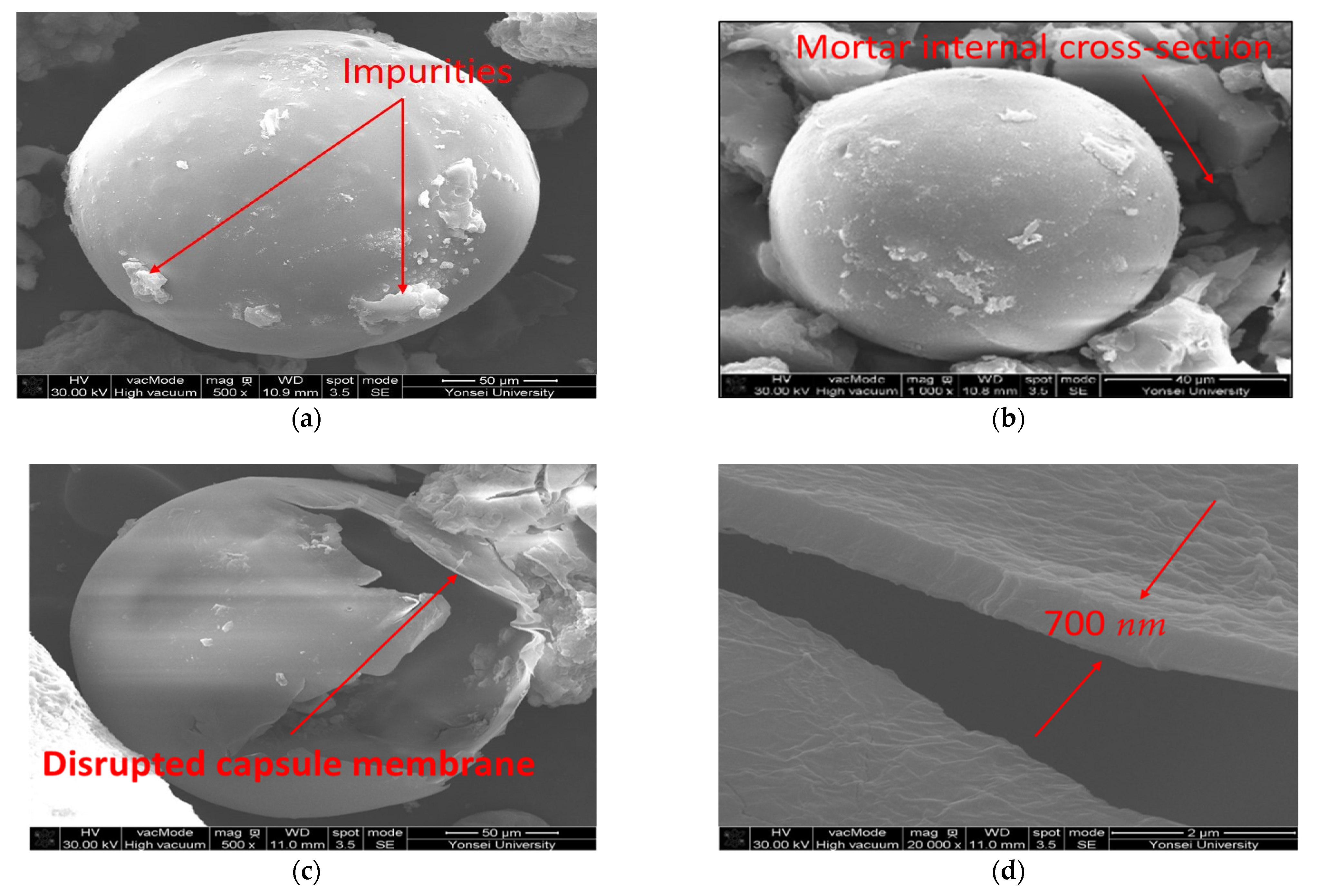

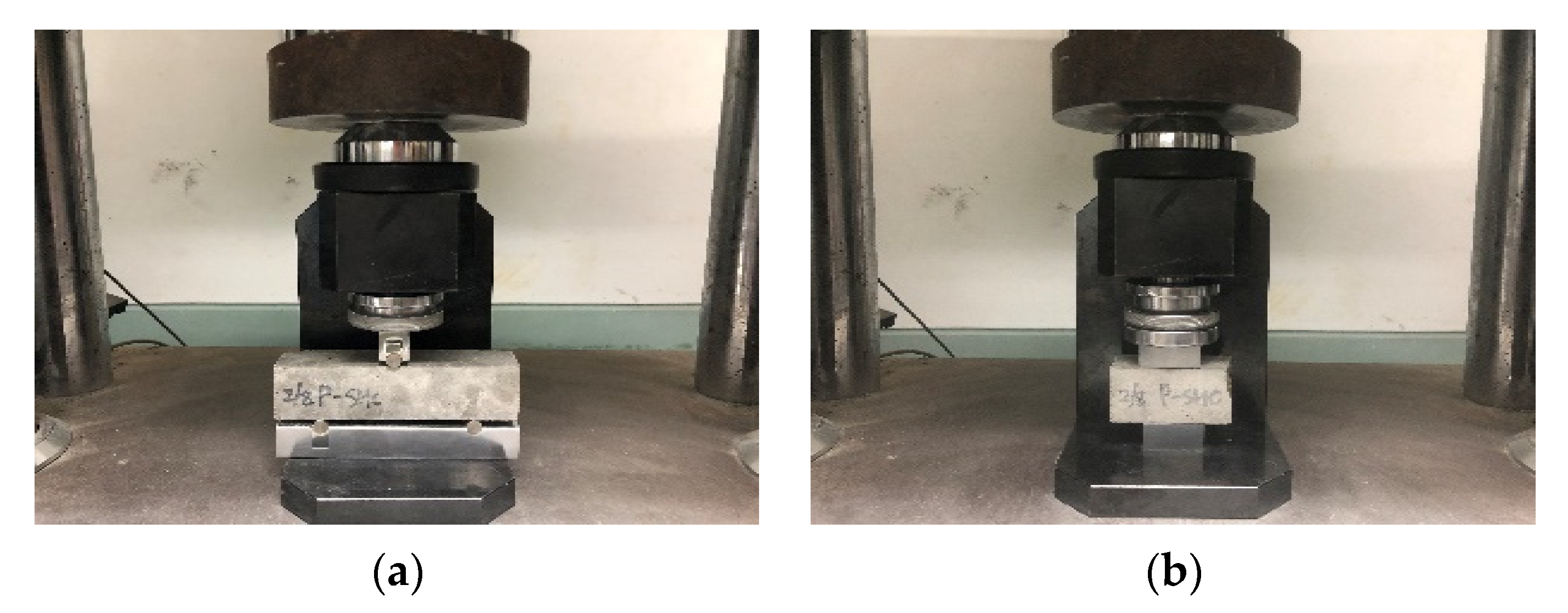
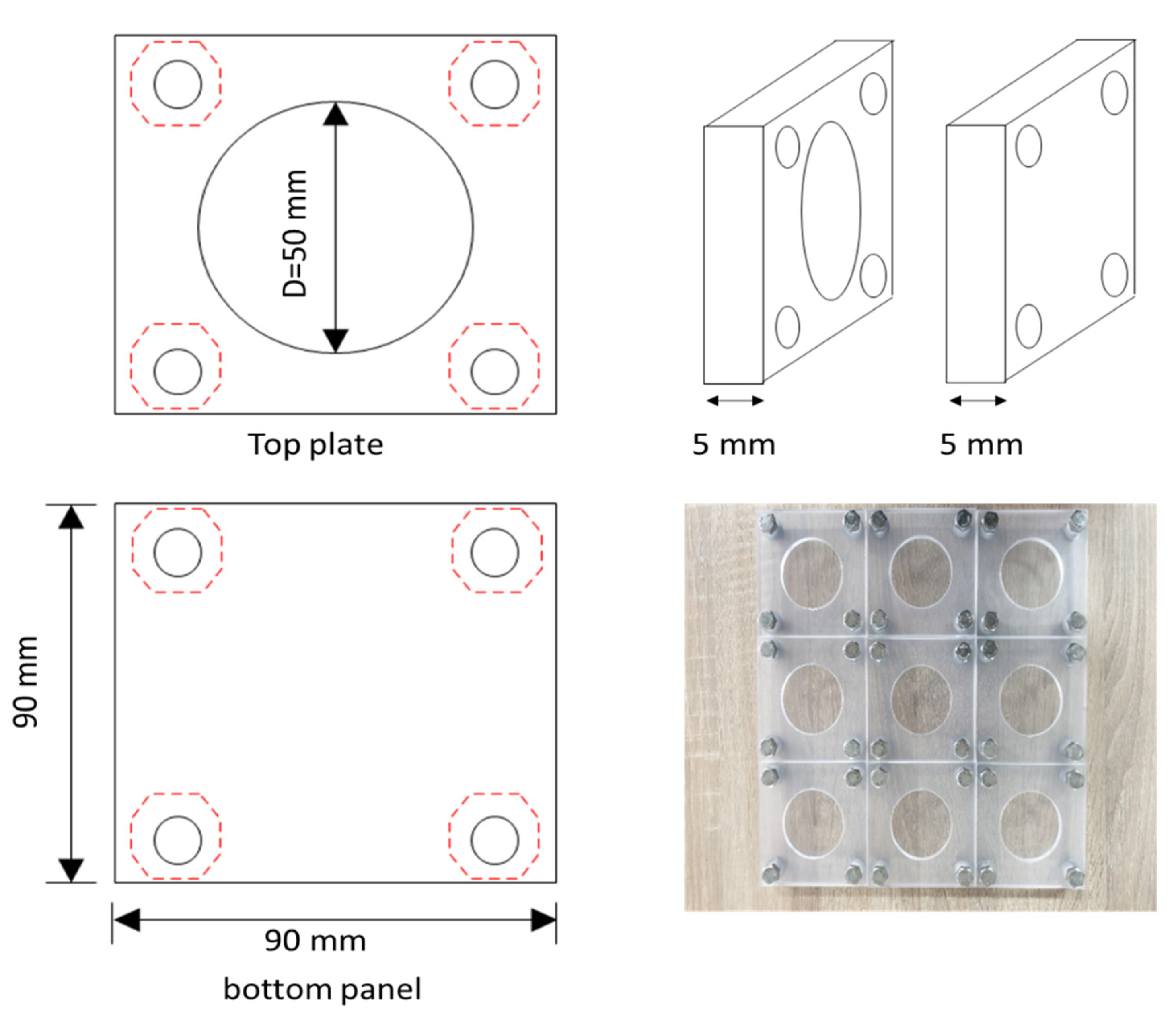

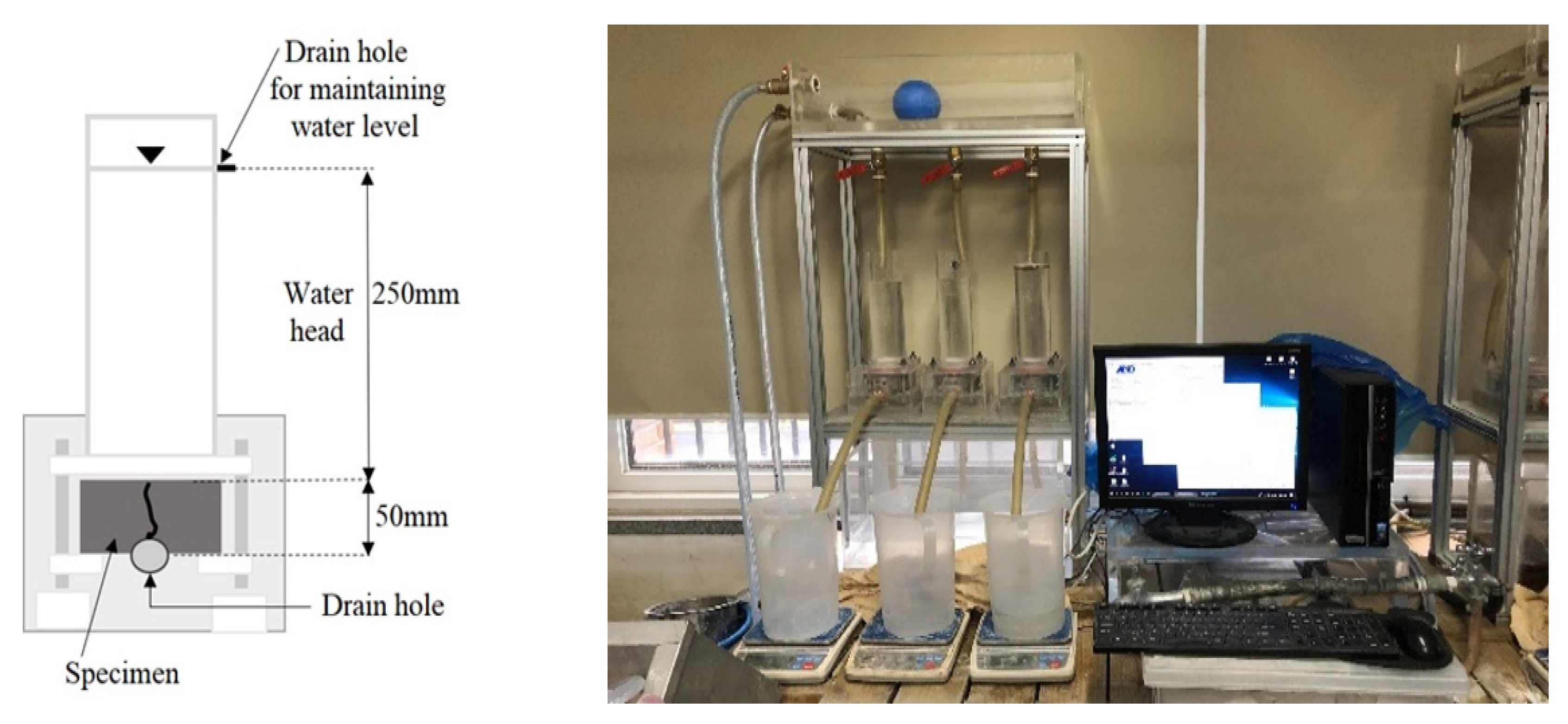
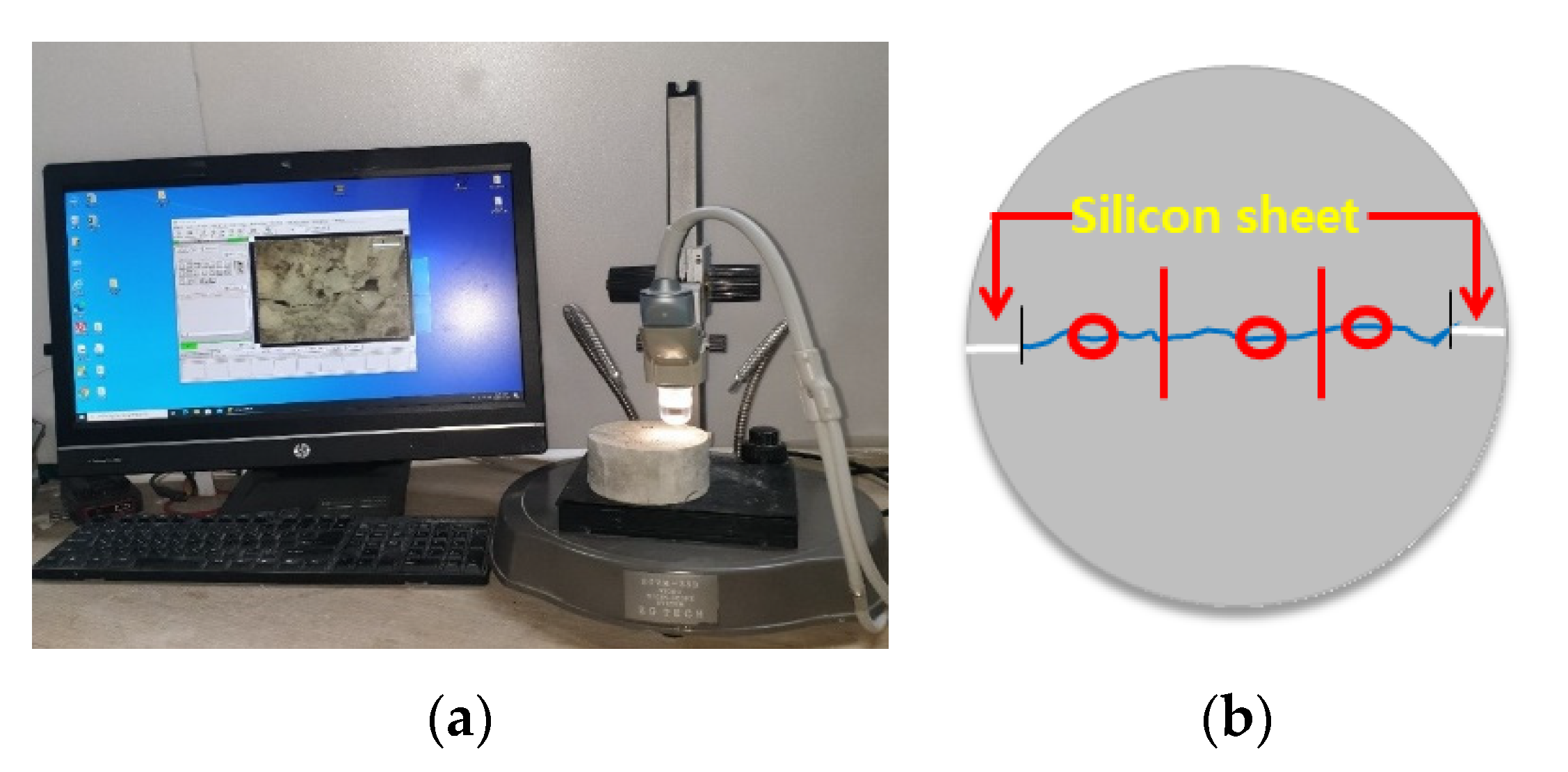
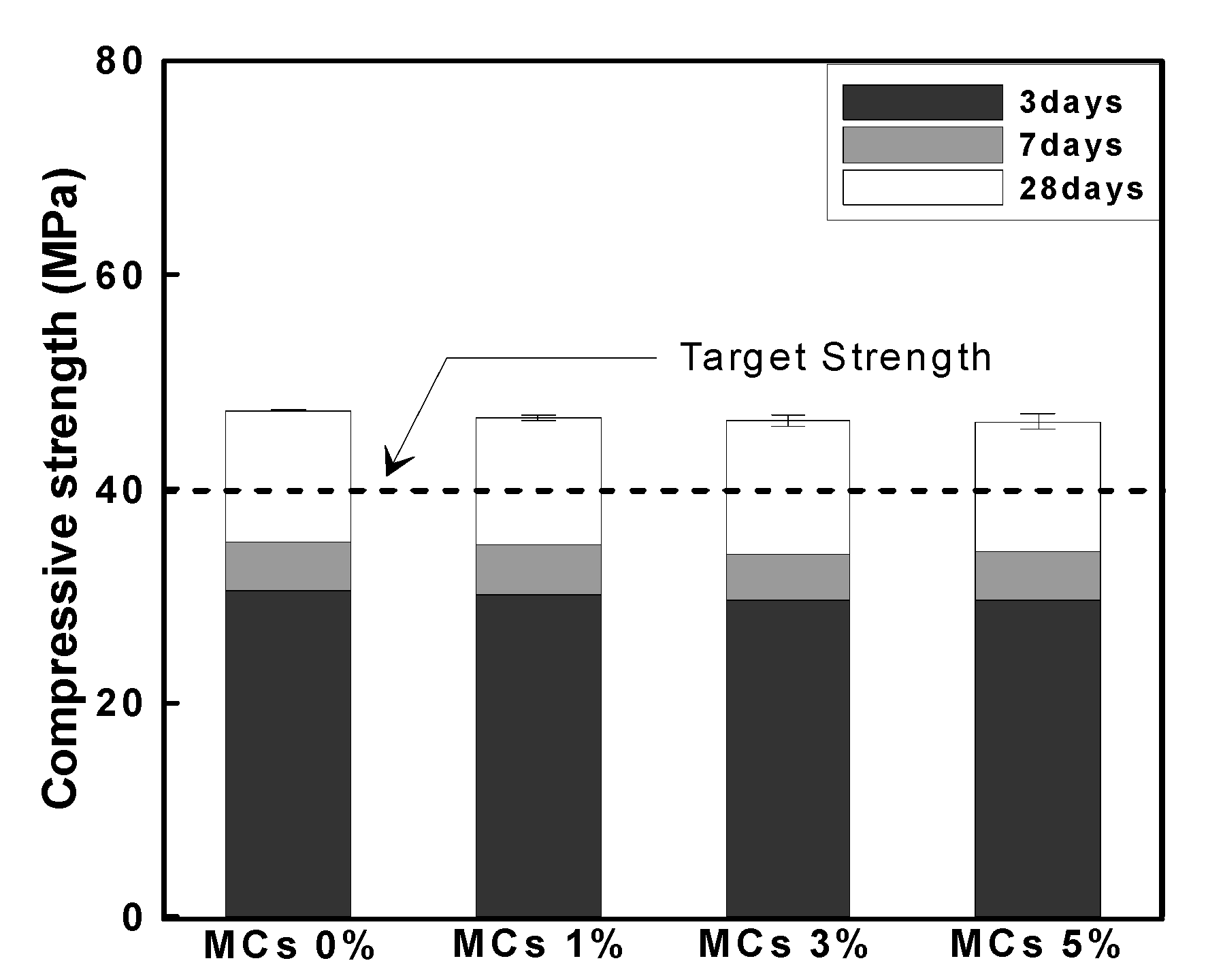
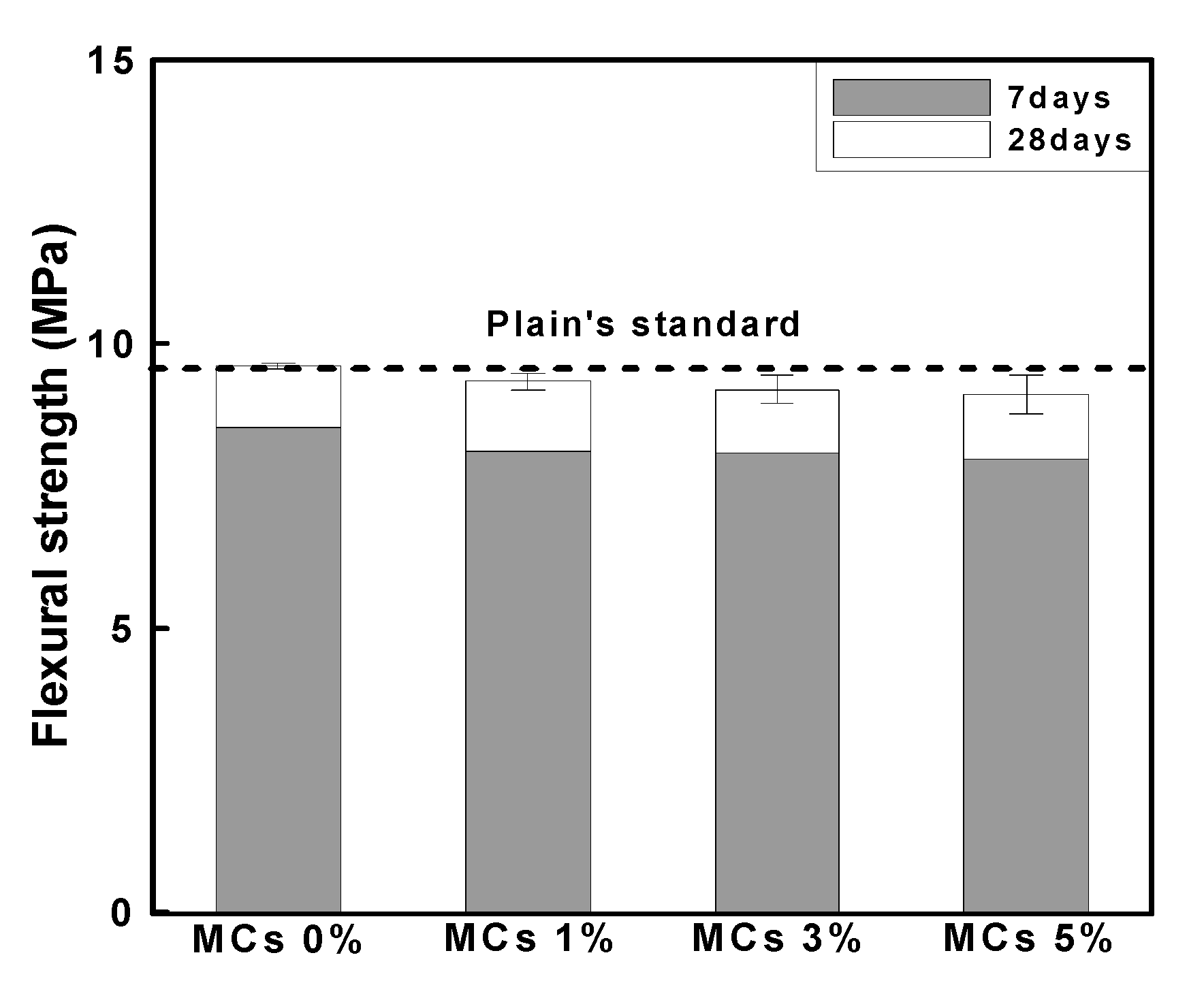
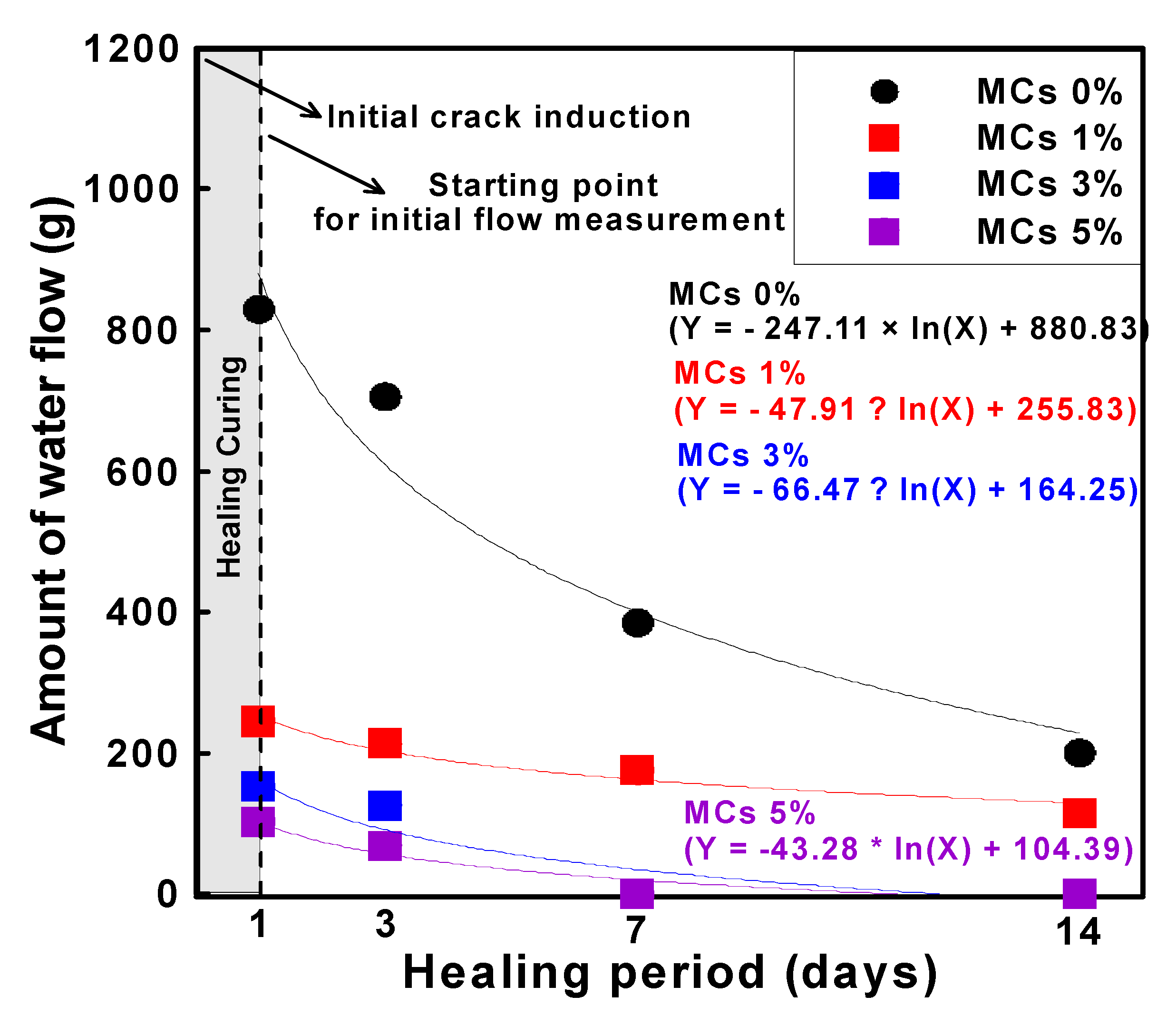

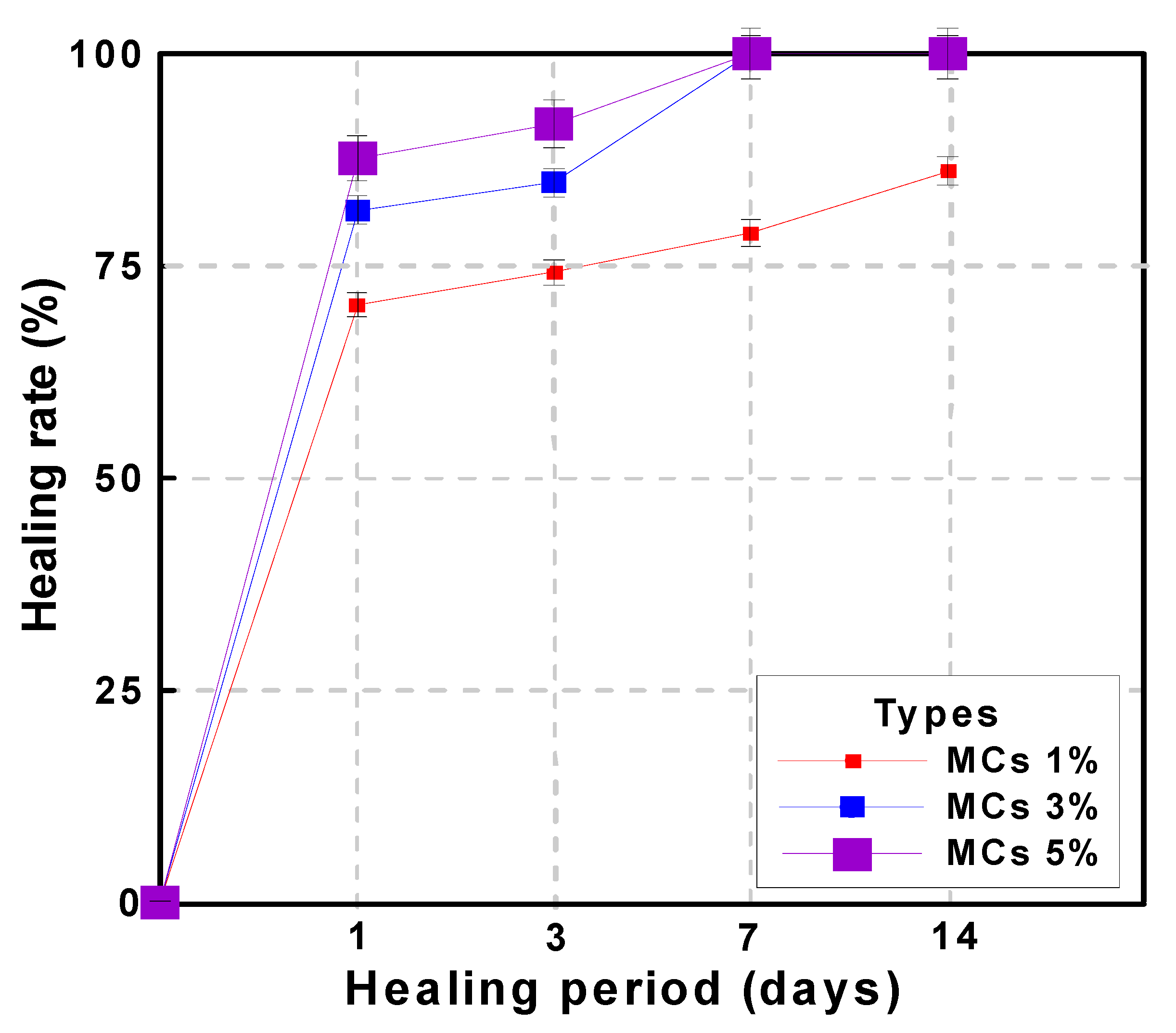




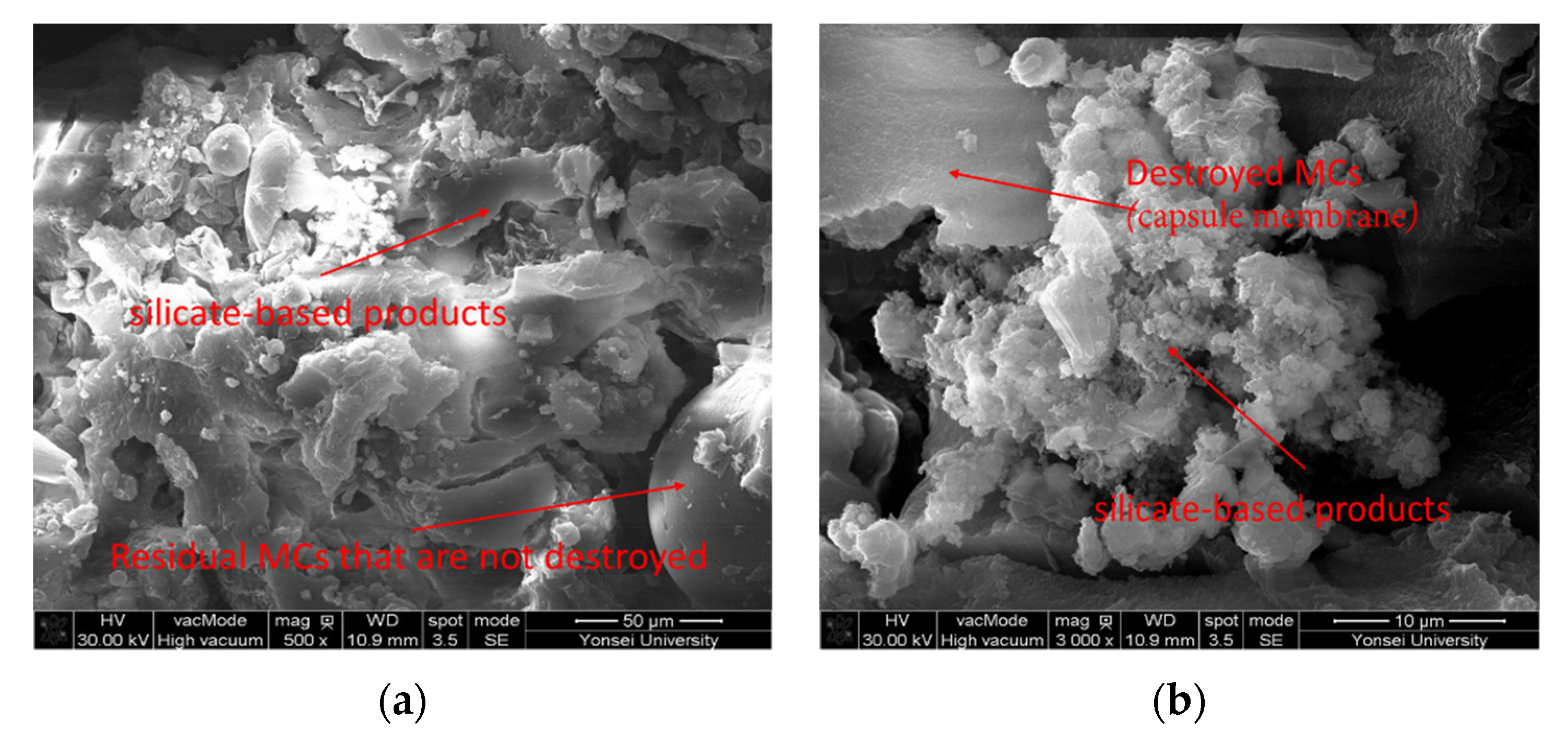
| Item | Specific Gravity (20 °C) | K2O (%) | Na2O (%) | Li2O (%) | SiO2 (%) | Fe2O3 (%) | Mole Fraction | Viscosity (Cps, 20 °C) | Solids Content (%) |
|---|---|---|---|---|---|---|---|---|---|
| Potassium silicates | 1.27–1.29 | 10.0–11.0 | - | - | 21.5–22.5 | 0.05 | 3.2–3.5 | ≤20 | 20–52 |
| Sodium silicates | ≥1.38 | - | 9.0–10.0 | - | 28.0–30.0 | 0.03 | 3.10–3.30 | - | 30–56 |
| Lithium silicates | 1.15–1.20 | - | - | 1.0–1.5 | 18.0–22.0 | - | 7.5–8.5 | - | 20–25 |
| Type | W | C | S | MCs (C × %) | Ad. (C × %) |
|---|---|---|---|---|---|
| MCs 0% | 0.4 | 1 | 2 | 0 | 0.5–0.6 |
| MCs 1% | 0.4 | 1 | 2 | 1 | |
| MCs 3% | 0.4 | 1 | 2 | 3 | |
| MCs 5% | 0.4 | 1 | 2 | 5 |
| Size of Sieve (mm) | 2 | 1.6 | 1.0 | 0.5 | 0.16 | 0.08 |
|---|---|---|---|---|---|---|
| cumulative residue of sieve (%) | 0 | 7 ± 5 | 33 ± 5 | 67 ± 5 | 87 ± 5 | 99 ± 1 |
| Types | MCs | Relative Ratio (%) | |||||
|---|---|---|---|---|---|---|---|
| Rheological Parameters | 0% (Plain) | 1% | 3% | 5% | 1% | 3% | 5% |
| Plastic viscosity (Pa·s) | 24.5 | 22.2 | 20.6 | 18.1 | −9.4 | −15.9 | −26.1 |
| Yield stress (Pa) | 211 | 152 | 165 | 174 | −28.0 | −21.8 | −17.5 |
| Types | MCs | Relative Ratio (%) | |||||
|---|---|---|---|---|---|---|---|
| 0% (Plain) | 1% | 3% | 5% | 1% | 3% | 5% | |
| Flow (mm) | 180 | 170 | 160 | 150 | −5.6 | −11.1 | −16.7 |
| Air content (%) | 6.0 | 6.1 | 5.9 | 5.8 | +1.7 | −1.7 | −3.3 |
| Types | Water Flow (g) according to the Healing Period (Days) | Healing Rate (Equation (2)) | |||||
|---|---|---|---|---|---|---|---|
| 1 | 3 | 7 | 14 | 3 | 7 | 14 | |
| MCs 0% | 829 | 705 | 384.75 | 200.1 | 15.0 | 53.6 | 75.9 |
| MCs 1% | 246 | 214 | 176 | 115 | 74.2 | 78.8 | 86.1 |
| MCs 3% | 153 | 126.2 | 0 | 0 | 84.8 | 100.0 | 100.0 |
| MCs 5% | 102.6 | 69 | 0 | 0 | 91.7 | 100.0 | 100.0 |
Publisher’s Note: MDPI stays neutral with regard to jurisdictional claims in published maps and institutional affiliations. |
© 2022 by the authors. Licensee MDPI, Basel, Switzerland. This article is an open access article distributed under the terms and conditions of the Creative Commons Attribution (CC BY) license (https://creativecommons.org/licenses/by/4.0/).
Share and Cite
Kim, C.-G.; Choi, Y.-W.; Choi, S.; Oh, S.-R. A Study on the Healing Performance of Mortar with Microcapsules Using Silicate-Based Inorganic Materials. Materials 2022, 15, 8907. https://doi.org/10.3390/ma15248907
Kim C-G, Choi Y-W, Choi S, Oh S-R. A Study on the Healing Performance of Mortar with Microcapsules Using Silicate-Based Inorganic Materials. Materials. 2022; 15(24):8907. https://doi.org/10.3390/ma15248907
Chicago/Turabian StyleKim, Cheol-Gyu, Yun-Wang Choi, Sung Choi, and Sung-Rok Oh. 2022. "A Study on the Healing Performance of Mortar with Microcapsules Using Silicate-Based Inorganic Materials" Materials 15, no. 24: 8907. https://doi.org/10.3390/ma15248907
APA StyleKim, C.-G., Choi, Y.-W., Choi, S., & Oh, S.-R. (2022). A Study on the Healing Performance of Mortar with Microcapsules Using Silicate-Based Inorganic Materials. Materials, 15(24), 8907. https://doi.org/10.3390/ma15248907






